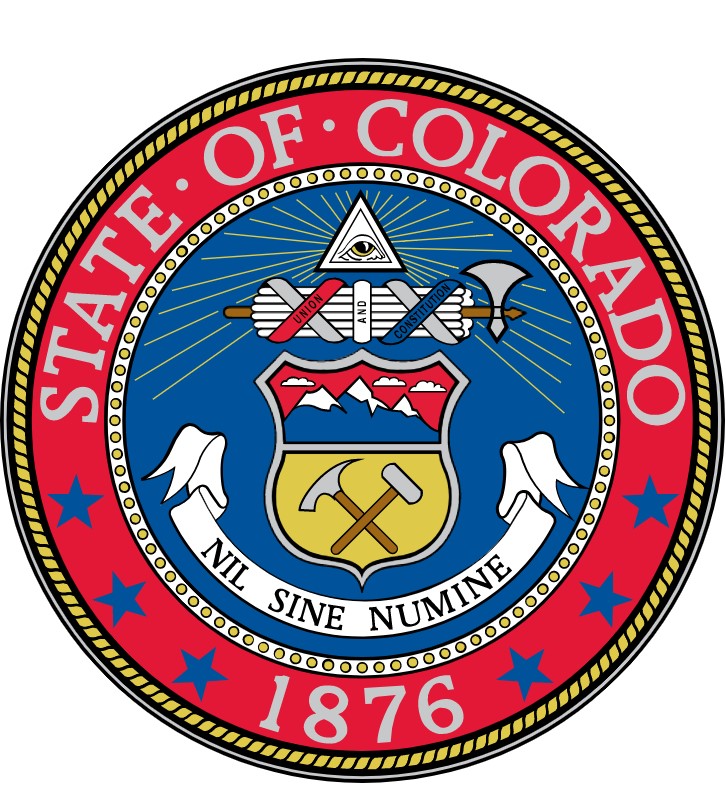Dave Young,
State Treasurer
About
Learn about State of Colorado, including Featured News, Key Projects, The Team, and Credit Summaries.





View 5 Photos
- Population (2022 est.)
- 5,890,000
- Notes, Bonds & COPs Outstanding (as of 6/30/2021)
- $5.187 billion
- Total Revenue (FY2022)
- $30.104 billion
About State of Colorado
Colorado became the 38th state of the United States of America when it was admitted to the union in 1876. Its borders encompass 103,718 square miles of the high plains and the Rocky Mountains, with elevations ranging from 3,315 to 14,433 feet above sea level. The current population of the State is approximately 5.76 million. The State’s major economic sectors include agriculture, professional and business services, manufacturing, technology, tourism, energy production and mining. Considerable economic activity is generated in support of these sectors by government, wholesale and retail trade, transportation, communications, public utilities, finance, insurance, real estate and other services
The State Constitution provides that the State Treasurer is to be the custodian of public funds in the State Treasurer’s care, subject to legislative direction concerning safekeeping and management of such funds. The State Treasurer is the head of the statutorily created Department of the Treasury (the “State Treasury”), which receives all State moneys collected by or otherwise coming into the hands of any officer, department, institution or agency of the State (except certain institutions of higher education). The State Treasurer deposits and disburses those moneys in the manner prescribed by law. Every officer, department, institution and agency of the State (except for certain institutions of higher education) 34 charged with the responsibility of collecting taxes, licenses, fees and permits imposed by law and of collecting or accepting tuition, rentals, receipts from the sale of property and other moneys accruing to the State from any source is required to transmit those moneys to the State Treasury under procedures prescribed by law or by fiscal rules promulgated by the Office of the State Controller. The State Treasurer and the State Controller may authorize any department, institution or agency collecting or receiving State moneys to deposit such moneys to a depository to the State Treasurer’s credit in lieu of transmitting such moneys to the State Treasury.
Featured News
March 1, 2024
Press Release
Treasurer's Office Press Releases
Please click the link below to access the Treasurer's press releases
Key Projects
View ProjectsThe Team
Dave Young
State Treasurer
Credit Summaries
ETRAN (Education Loan Program Tax and Revenue Anticipation Notes)
Timing differences between revenue collections and disbursements cause many Colorado school districts to incur annual cash flow deficits. The salaries of some school district employees are paid over a 12-month period, and some school district expenses occur on a relatively consistent monthly basis, although most salaries and expenses of school districts are incurred during the traditional school year of September through May. The primary sources of revenue to school districts to meet these expenditures include (i) funding from the State pursuant to Article 54 of Title 22, C.R.S., known as the Public School Finance Act of 1994 (the “Public School Finance Act”), which is received in approximately equal monthly amounts throughout the July 1-June 30 fiscal year of the school districts and the State (the “Fiscal Year”), and (ii) property taxes levied by the school districts, most of which are received in March through June when property taxes are paid by taxpayers. As a result, school districts often experience cash flow shortages during the fall and winter months before such tax revenues are received. School districts may address this cash flow shortage in a variety of ways, including: (i) borrowing funds from the State; (ii) transferring funds to the school district’s general fund from other school district funds on a short-term basis; (iii) borrowing funds on a short-term basis through the issuance by the school district of tax anticipation notes; or (iv) borrowing funds on a short-term basis from a bank or other lender.
GTRAN (General Fund Tax and Revenue Anticipation Notes)
The Funds Management Act of 1986 (the Funds Management Act), being Title 24, Article 75, Part 9, Colorado Revised Statutes, as amended (C.R.S.), authorizes the State Treasurer to issue and sell notes from time to time payable from the anticipated revenues of any one or more funds or groups of accounts to which State moneys are credited in order to accomplish any of the purposes of such Act, including the alleviation of cash flow shortfalls in any such fund or group of accounts.
The Funds Management Act provides a means of compensating for the fluctuations in revenues and expenditures that occur in the States General Fund, which is the States principal operating fund, during the Fiscal Year (July 1-June 30), and result in temporary cash flow shortfalls in the General Fund.
Higher Education Capital Construction
The Mineral Revenues Act created the Higher Education Federal Mineral Lease Revenues Fund to provide funding for Approved Projects for Participating Institutions. The Lease Purchase Act authorizes the State Treasurer to enter into Leases for Approved Projects, provided that the anticipated annual State-funded payments (which, for this purpose, does not include the Base Rent payable by certain of the 2008 Participating Institutions under the 2008 Subleases) for the principal and interest components of the amounts payable under such Leases shall not exceed an average of $16,200,000 per Fiscal Year during the ten-year period commencing with Fiscal Year 2008-09 through and including Fiscal Year 2017-18 or an average of $16,800,000 during the ten-year period commencing with Fiscal Year 2018-19 through and including Fiscal Year 2027-28 (the "Maximum Average Annual Base Rent"). The Colorado General Assembly, in its 2008 legislative session, adopted the 2008 Joint Resolution, approving the 2008 Projects for the 2008 Participating Institutions as Approved Projects for funding under the Authorizing Legislation. Pursuant to the 2012 Authorization, the Colorado General Assembly approved the 12-1357 Projects for the 12-1357 Participating Institutions as Approved Projects for funding under the Authorizing Legislation. The General Assembly established the Higher Education Capital Construction Lease Purchase Financing Program (the "Program") and designated the State Treasurer to implement the Authorizing Legislation.
BEST (Building Excellent Schools Today)
Established in 2008 with the signing of C.R.S.22-43.7, BEST provides an annual amount of funding in the form of competitive grants to school districts, charter schools, institute charter schools, boards of cooperative educational services, and the Colorado School for the Deaf and the Blind. BEST funds can be used for the construction of new schools as well as general construction and renovation of existing school facility systems and structures.
SB17-267 (Rural Colorado)
The Colorado General Assembly’s legislative declaration for the passage of SB 20-219 cites: the unprecedented economic situation of the State and the importance of funding the continuation of certain previously funded capital construction projects because of the declared disaster emergency due to the COVID-19 pandemic; the particular importance of funding the continuation of certain previously funded capital construction projects because there are cost escalations due to construction inflation when a project is postponed, there are repair, maintenance, and upkeep cost to minimize damage to the ongoing project or existing infrastructure while funding is delayed, and there may be increased operational cost for any project continuation alternatives; and, funding the continuations of certain previously funded capital construction projects in a time of economic downturn helps boost local economies with construction projects that can commence quickly when the money is made available. SB 20-219 authorizes, among other things, the creation of a lease-purchase agreement on existing facilities for the purpose of funding previously funded capital construction projects at State institutions of higher education. SB 20-219 directed the Capital Development Committee of the General Assembly to publish a list of specific projects authorized for funding pursuant to SB 20-219 and the cost of each project no later than August 15, 2020. Published on August 11, 2020, the list identified: Colorado State University, Shepardson Building Renovation and Addition ($17,051,200) (the “CSU Project”); Fort Lewis College, Health Sciences Center ($26,571,891) (the “Ft. Lewis Project”); and, University of Colorado, Anschutz Health Sciences Building ($21,859,241) (the “CU Anschutz Project” and, collectively with the CSU Project and the Ft. Lewis Project, the “Projects”). To finance the Projects, pursuant to SB 20-219, the State is authorized to execute a lease-purchase agreement in an amount not to exceed $65.5 million, plus reasonable and necessary administrative, monitoring and closing costs and interest, including capitalized interest and credit enhancement costs such as a debt service reserve fund or bond insurance. The annual repayment obligation may not exceed $5.5 million and principal amortization may not occur before July 1, 2022. If the financing raises money in excess of what is required for the Projects, SB 20-219 directs that those moneys be credited to the Emergency Controlled Maintenance Account of the Capital Construction Fund and that the Capital Development Committee will specify the use of those excess funds on or before June 30, 2021.
Higher Education Lease Purchase Financing Program
The Colorado General Assembly’s legislative declaration for the passage of SB 20-219 cites: the unprecedented economic situation of the State and the importance of funding the continuation of certain previously funded capital construction projects because of the declared disaster emergency due to the COVID-19 pandemic; the particular importance of funding the continuation of certain previously funded capital construction projects because there are cost escalations due to construction inflation when a project is postponed, there are repair, maintenance, and upkeep cost to minimize damage to the ongoing project or existing infrastructure while funding is delayed, and there may be increased operational cost for any project continuation alternatives; and, funding the continuations of certain previously funded capital construction projects in a time of economic downturn helps boost local economies with construction projects that can commence quickly when the money is made available. SB 20-219 authorizes, among other things, the creation of a lease-purchase agreement on existing facilities for the purpose of funding previously funded capital construction projects at State institutions of higher education. SB 20-219 directed the Capital Development Committee of the General Assembly to publish a list of specific projects authorized for funding pursuant to SB 20-219 and the cost of each project no later than August 15, 2020. Published on August 11, 2020, the list identified: Colorado State University, Shepardson Building Renovation and Addition ($17,051,200) (the “CSU Project”); Fort Lewis College, Health Sciences Center ($26,571,891) (the “Ft. Lewis Project”); and, University of Colorado, Anschutz Health Sciences Building ($21,859,241) (the “CU Anschutz Project” and, collectively with the CSU Project and the Ft. Lewis Project, the “Projects”). To finance the Projects, pursuant to SB 20-219, the State is authorized to execute a lease-purchase agreement in an amount not to exceed $65.5 million, plus reasonable and necessary administrative, monitoring and closing costs and interest, including capitalized interest and credit enhancement costs such as a debt service reserve fund or bond insurance. The annual repayment obligation may not exceed $5.5 million and principal amortization may not occur before July 1, 2022. If the financing raises money in excess of what is required for the Projects, SB 20-219 directs that those moneys be credited to the Emergency Controlled Maintenance Account of the Capital Construction Fund and that the Capital Development Committee will specify the use of those excess funds on or before June 30, 2021.

